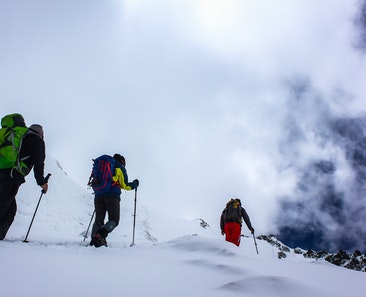Traveling Out of Season
We are living in a Golden Age of Travel. One of the great benefits of living in our time is that the accessibility of travel has grown by leaps and bounds.
In 1950 only 1 percent of Americans traveled abroad. Transatlantic jet travel didn’t become available until 1959, and until the mid-1960s most people who traveled to Europe took a cruise ship that took four or five days to cross the Atlantic. Travel has become so much easier, and today 76 percent of Americans have traveled abroad.
How fortunate we are to live in this period, when there is a head-spinning variety of fantastic travel opportunities that are easy and affordable to a broad segment of the population. But, as with any good thing, there are drawbacks to the modern miracle of international travel. The worst of those is overtourism.
In today’s world, the most popular tourist attractions are at times so overcrowded that it detracts from the experience for everyone, the visitors themselves, local residents, and even the local vendors, who theoretically make more money the more customers they have. But sometimes even for them, the overcrowding is too much.
We are now beyond the time when you can just blindly walk up to a popular attraction and be sure you’re going to have a great experience. Overcrowding is an element that must be taken into consideration by everyone involved in travel planning. The phenomenon of overtourism is with us now, but it is possible to navigate around it.

There are two options for spreading out travelers. One is to spread them out spatially by introducing them to new destinations beyond the well-trodden tourist path.
Some city governments in major tourist cities such as Venice, Barcelona, Amsterdam and Dubrovnik have taken steps to try to redistribute travelers to ease the pressure of too many tourists in one place at one time.
Destination marketing organizations are working with tour operators to promote lesser-known attractions in their regions, to take travelers beyond the standard, most popular tourist attractions. It not only helps them avoid crowds, but also helps them to expand their horizons, exploring deeper into the country beyond the top tourist attractions. It is part of a cooperative effort among those in the tourism community to manage the evolving expansion of travelers’ horizons.
The second way to redistribute tourist traffic is to spread it around the calendar. That brings us to off-season travel. By steering clear of the peak of the bell curve, you can avoid arriving when the largest numbers of travelers are arriving with you.
The efforts are making a difference, but smart travelers also need to take overtourism into consideration in their trip planning. It’s possible to make the ebbs and flows of tourist traffic work in your favor.
Overcrowding is only one of the reasons to travel off season, maybe not even the most important. It also means better prices and more availability of everything, including lodging, transportation, restaurant reservations and admission to all the popular attractions. Most of those businesses are still there in the off season, but they aren’t crowded, and they have some breathing room to pay more attention to you. They really appreciate your business.
At peak season, you are likely to have to stand in long lines to get into the most popular attractions. What a relief to travel during off-peak times and find that problem has disappeared.
I looked into it recently and found that the summer travel season is a tradition that dates to the 19th century. Contrary to what I had previously thought, it didn’t come out of farm country. It originated in urban areas like New York, where summers were so brutally hot before air conditioning that practically anyone who could got out of the city. In any case, whatever it’s based on, it’s a good tradition to break. There are good reasons to break it.
I am speaking as one who enjoys crowds. Being around people is one of the greatest pleasures of traveling. I love my times of quiet solitude as well, but big groups of people can be exhilarating. People-watching is one of my favorite activities anywhere I go. It’s not that I’m antisocial. But there is a point at which crowding is just too much.
People usually learn of overtourism by accident at first. When I managed to fulfill a long-held wish to see the Lost City of Machu Picchu, I was fortunate to be able to stay at the Sanctuary Hotel on the mountaintop at the edge of the ancient citadel. My hotel room had a view of the site, a tight close-up of the view you see in the standard pictures of Machu Picchu.
But it was jarring to see in the foreground something that never appears in the pictures, a crowd of people and vendors gathered at the gate to the site. Fortunately, once we got into the grounds, there was a lot of space to spread out.
Because my group was staying in the hotel next to the site, we were able to tour the site at sunrise, before the crowds had gathered. What a contrast! It was quietly spectacular and mystical, unforgettably mind-blowing. At sunrise it was more of the serene scene you would imagine it from photographs.
I must add here that as spellbinding as the photographs of Machu Picchu are, they don’t deliver one one-thousandth of the experience of seeing it in actuality, of being able to walk the grounds and see it from many angles. The vastness of the city, the ruins of its architecture, the heady altitude, the rows of mountains cascading out to the horizon, all of this and much more are far beyond capture by any camera. So, deservedly, Machu Picchu is one of the places that gets so many visitors that it’s creating problems that have to be managed.
So overtourism is real, and must be taken into consideration. It’s important to have an experienced travel agent who can help navigate the ever-shifting technicalities of the great tourist sites, and give you an update on when sites are overcrowded and how to avoid the crowds. It varies by destination and season.
There are many places where off-season travel is particularly appropriate. Florence, the home of the Renaissance, is incomparable and should be on everyone’s aspirational travel list. Of course, Italy in the summer is lovely. But people don’t travel to Florence to sit in the sun. More often they want to take advantage of what makes Florence unique, and that’s art. Most of which is seen indoors. If it’s not a beautiful day outside, it doesn’t matter much in a museum.
Most of the world’s favorite destinations are just as pleasant and beautiful after the summer peak season is over. And they can be just as much fun as the calendar rolls into winter. Some pleasures are exclusive to the winter off-season. For example, the Christmas markets in Germany have become one of the most popular travel experiences, and they are strictly in December, far beyond the crowding of the summer peak season.
I fell into off-season travel unintentionally, but it was a pleasant surprise. When I first went to London I was working at an outdoor kiosk in New York City that was driven by tourism. Summer tourist season was our time to make hay, so there was no way I could travel during the summer. So when I first encountered London it was late fall. I expected the characteristic London fog and drizzle, but it was nothing like that. It was sunny and warm and invigorating, along with the excitement of finally seeing London and all the things I knew from photographs and movies. The weather was about as perfect as it could be.
I’ve always tended to be a bit out of season, and there are so many advantages to avoiding the rush. If you haven’t tried it, I heartily recommend it.
Your humble reporter,
A. Colin Treadwell
The post Traveling Out of Season appeared first on The Taucker Travel Blog.



